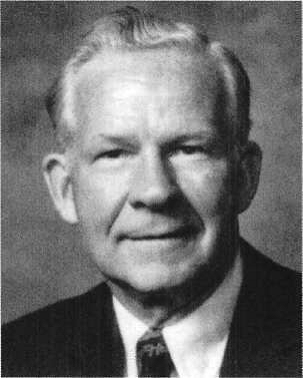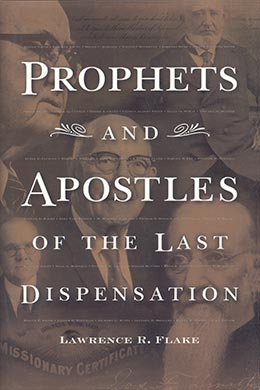Marvin Jeremy Ashton
Lawrence R. Flake, Prophets and Apostles of the Last Dispensation (Provo, UT: Religious Studies Center, Brigham Young University, 2001), 509–12.

Born: 6 May 1915, Salt Lake City, Utah
Assistant to the Quorum of the Twelve: 3 October 1969
Quorum of the Twelve Apostles: 2 December 1971 (age 56)
Died: 25 February 1994 (age 78), Salt Lake City, Utah
When Marvin J. Ashton received his call as a member of the Quorum of the Twelve Apostles, some friends who had known his father, the late Marvin O. Ashton, counselor in the Presiding Bishopric of the Church, commented: “Your father must be smiling with a great deal of pleasure at your appointment” Elder Ashton responded, “If I know my father . . . he would take more time to suggest, ‘Son, you have not arrived. You have not reached your destination. Your great test lies ahead of you. Strive to live worthy of the great trust placed in you.’” [1] Elder Ashton did live up to the trust placed in him by rendering a lifetime of unusual service to the kingdom.
Elder Ashton had great rapport with and compassion for the youth of the Church, and he served them many years in the scouting program and as advisor to the Young Men and the Young Men’s Mutual Improvement Association. His real trademark, however, was the great humanitarian service he rendered to the downtrodden, the wayward, and the afflicted. As managing director of Church Social Services, he made great contributions helping those involved in serious problems: “There was great satisfaction to be found with the Indian Placement Program and the programs for unwed mothers, alcoholics, prisoners and those having social and emotional problems. I have a fond feeling in my heart for them” [2] Many of Elder Ashton’s associates have expressed how ideally he was suited to this task: “He is a true humanitarian, one who can and does help the sick at heart, the sick in mind, and those who need human understanding.” [3] President Monson described Elder Ashton’s philosophy: “He had confidence in the nobility of the human soul. He knew each soul had the capacity to become as God, and he treated him or her accordingly, not for what he was but for what he could and should become.” [4]
Elder Ashton was born in 1915 and grew up in the Parley area, which was then on the outskirts of Salt Lake City. As a child he heard the coyotes howl through his open bedroom window. The family had two acres and raised just enough rabbits, pigeons, fruit, and vegetables to teach the children the meaning of work. Marvin also worked in the hardware department of his father’s lumber mill business and put himself through the University of Utah, graduating in 1936 in the field of business.
He also earned all of his own money to go on a mission—720 dollars for twenty-four months. In 1937 he was called to Great Britain, where he served under President Hugh B. Brown. He distinguished himself by selling the most subscriptions to the Millennial Star in one of the mission’s proselytizing efforts. He subsequently became the associate editor of that publication and the supervising elder of the mission office. He was also the captain of an excellent missionary basketball team, which succeeded in winning not only friends for the Church but also the all-Europe championship in Lille, France. His love for athletics continued after his mission. He and his wife, the former Norma Berntson, won the all-Church tennis mixed doubles tournament. Norma’s family had a tennis court in their backyard, which provided the young couple an opportunity to play tennis many hours during their courtship. They were married in 1940 and became the parents of two daughters and two sons.
Before his call to be an Assistant to the Quorum of the Twelve in 1969, Elder Ashton had established a successful career in the wholesale lumber business and had distinguished himself as a civil servant, serving in many capacities including Utah state senator, member of the White House Conference on Youth, member of the Utah State Board of Alcohol and Drugs, and member of the Utah State Mental Health committee. His call to the apostleship came in December 1971; he served for twenty-two years in that Quorum until his death in 1994.
Elder Ashton shared with members of the Church his great insight about receiving a testimony in telling one of his experiences as a young missionary: “When I arrived in the mission field, I decided that after just a few weeks I wanted to have that burning testimony others had spoken of.” [5] He decided to read the Book of Mormon and pray about it. Disappointed that he “didn’t hear those bells or the voice or have those feelings,” he decided to read the book again. Still no dramatic incident ensued. He read the book again. “After finishing it the third time and praying about it, I had the impression, ‘You’ve known the Church is true all your life. Get off your knees and go to work.’ That was a distinct impression. I had been seeking a testimony, but I already had it . . . . Since I’ve become a General Authority, I’ve spent quite a bit of time talking to missionaries about two types of testimonies. One is the kind that comes as a sudden impact, usually the type the convert comes to know. The other is the quiet testimony that is there and just needs the chance to blossom and grow.” [6]
At Elder Ashton’s funeral, Elder Jeffrey R. Holland described the physical ailment that came to Elder Ashton at the end of his life. Having enjoyed rigorous physical activity and exercise all of his life, Elder Ashton fell prey to a disease that “made his right foot terribly ulcerated and sore—literally an open wound. Finally he simply could not stand the pain of wearing his right shoe, so he took it off and kept trying to work, literally, in his stocking feet.” [7] President Monson described his feelings after his last meeting with Elder Ashton. Seeing him so ill, he said, “I . . . literally wept, for I remembered the words of the poet, ‘Here and there and now and then, God places a giant among men.’ And I saw this giant of a man growing weak and frail, and I thanked God in a silent prayer for the sweet association I had had with Marvin J. Ashton.” [8]
Notes
[1] Marvin J. Ashton, “What is Your Destination?” Ensign, July 1972, 63.
[2] Gerry Avant, “Hourglass in Apostle’s Office Symbolizes Challenge with Time,” Church News, 18 August 1985, 5.
[3] Doyle L. Green, “Elder Marvin J. Ashton of the Council of the Twelve,” Ensign, March 1972, 23.
[4] “Elder Ashton a ‘Champion of Love/” Church News, 5 March 1994, 3.
[5] Avant, “Hourglass in Apostle’s Office,” 5.
[6] Avant, “Hourglass in Apostle’s Office,” 5.
[7] “Elder Ashton a ‘Champion of Love’” 4.
[8] “Elder Ashton a ‘Champion of Love’” 4; see also Jay M. Todd, “Marvin J. Ashton, Assistant to the Twelve,” Improvement Era, December 1969, 4–7.
